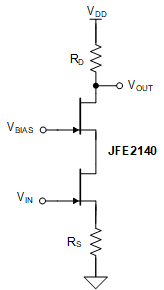JAJSJ74B August 2021 – August 2023 JFE2140
PRODUCTION DATA
- 1
- 1 特長
- 2 アプリケーション
- 3 概要
- 4 Revision History
- 5 Pin Configuration and Functions
- 6 Specifications
- 7 Parameter Measurement Information
- 8 Detailed Description
- 9 Application and Implementation
- 10Device and Documentation Support
- 11Mechanical, Packaging, and Orderable Information
9.1.2 Cascode Configuration
The JFE2140 can be configured as a cascoded JFET front end. Cascode refers to using a second transistor in-series with the input transistor; see Figure 9-2 for an example.
 Figure 9-2 JFE2140 connected in Cascode
Configuration
Figure 9-2 JFE2140 connected in Cascode
ConfigurationUsing a cascode configuration, as shown in Figure 9-2, increases the output impedance of the stage, resulting in higher gain, as well as buffers the input node from gate current that flows when the VDS voltages are higher. The VBIAS node must be forced to a voltage greater than what is required to allow both JFETs to remain in the saturated region. A JFET is not required to be used as the cascode device; the benefits of cascoding can be realized with other transistor types, while still maintaining the low-noise, high-impedance benefits of the JFE2140.